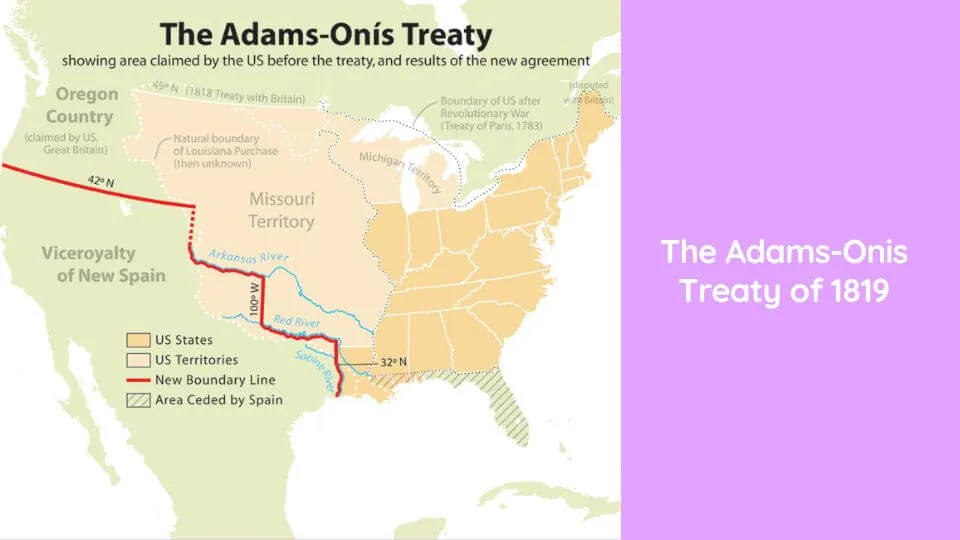| Adams–Onís Treaty |
| 1819 treaty between the United States and Spain |


| Overview | The Adams–Onís Treaty of 1819 was a historic agreement that ceded Florida to the U.S. and defined the boundary between the U.S. and New Spain (now Mexico), marking a triumph in American diplomacy. |
| Significance | Resolved a standing border dispute and facilitated Florida’s transition from Spanish control to becoming a U.S. territory through diplomatic efforts. |
| Negotiators | Negotiated by John Quincy Adams, U.S. Secretary of State, and Luis de Onís, Spanish minister plenipotentiary, under King Ferdinand VII of Spain. |
| Key Provisions | Spain ceded Florida to the U.S. and received up to $5 million for residents’ claims against Spain, along with the establishment of the U.S.-Mexico boundary through the Rocky Mountains to the Pacific Ocean. |
| Effective Period | The treaty was in full effect from February 22, 1821, until the Treaty of Córdoba in August 24, 1821, which led to Mexico gaining independence and assuming control of New Spain. |
| Languages | The treaty was drafted in both English and Spanish. |
The key details about the Adams-Onís Treaty of 1819 between the United States and Spain:
- Purpose:
- To settle a long-standing border dispute between the U.S. and Spain over territories in North America, including Florida and the Louisiana Purchase lands.
- To settle a long-standing border dispute between the U.S. and Spain over territories in North America, including Florida and the Louisiana Purchase lands.
- Terms of the Treaty:
- Spain ceded Florida to the United States, with the U.S. acquiring East Florida from Spain’s control and West Florida which the U.S. had already annexed in 1810.
- The treaty defined the western boundary of the Louisiana Purchase lands for the United States, generally along the Arkansas River watershed and the 42nd parallel north.
- Spain ceded all its claims and rights to the Pacific Northwest territory, known as the Oregon Country, to the United States.
- The United States gave up its claims on Spanish Texas and recognized Spain’s sovereignty over that territory.
- The United States agreed to pay claims by American citizens against Spain up to $5 million.
- The treaty reaffirmed the terms of the earlier Pinckney’s Treaty of 1795 between the U.S. and Spain.
- Spain ceded Florida to the United States, with the U.S. acquiring East Florida from Spain’s control and West Florida which the U.S. had already annexed in 1810.
- Significance:
- The treaty resolved the territorial ambiguities and disputes arising from the Louisiana Purchase and American westward expansion.
- It established a temporary boundary between American and Spanish claims in the West.
- It marked Spain’s ceding of Florida to the United States after years of contention.
- It paved the way for American settlement and expansion into Florida and the newly acquired lands.
- The treaty resolved the territorial ambiguities and disputes arising from the Louisiana Purchase and American westward expansion.
The Adams-Onís Treaty was a major diplomatic achievement that helped define the boundaries of the United States for several decades after 1819, while also transferring Florida from Spain. It resolved territorial issues that had lingered since the American Revolutionary era.